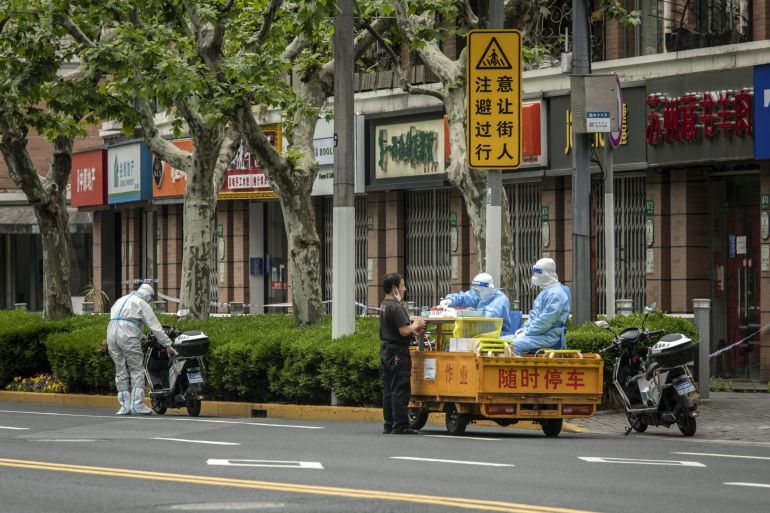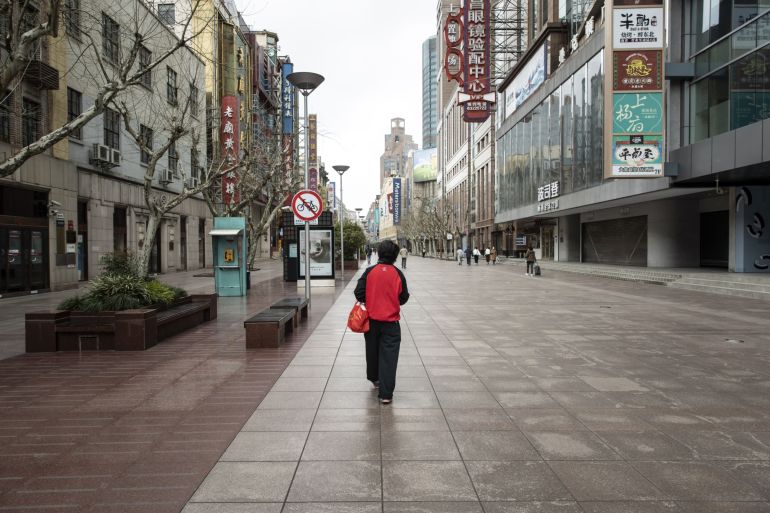‘Localised’ recessions? China’s economy teeters amid lockdowns
Economists warn of negative economic growth in certain sectors and regions if ‘zero COVID’ policy continues.

Taipei, Taiwan – China may be headed for negative economic growth in certain sectors and regions this year as it struggles with the worst economic indicators since the start of the pandemic, economic analysts have warned.
China’s Communist Party (CCP) has locked down tens of millions of people since the start of 2022 to contain the spread of the Omicron variant, severely impeding key economic sectors, including services and manufacturing.
Keep reading
list of 4 itemsFrugal Japanese tighten their belts as prices rise, yen slides
Teen murder charge shows ‘gaps’ in Malaysia’s treatment of girls
‘Huge step’: New Zealand to fully reopen borders on July 31
The draconian measures have disrupted production at factories operated by firms from Foxconn to Tesla and Toyota, and crimped retail sales as millions have been forced to stay at home.
The Purchasing Managers’ Index, a key metric that measures the health of the manufacturing sector, fell to 49.5 percent in March and 47.4 percent in April, according to China’s National Bureau of Statistics. A reading below 50 indicates a contraction. In Shanghai, the most populous city, first-quarter retail sales fell 3.8 percent compared with the previous year.
As Beijing warns against deviating from its controversial “dynamic Covid Zero” strategy, there are few signs of a respite from the economic bleeding on the horizon.
On Tuesday, WHO Director-General Tedros Adhanom Ghebreyesus said China’s strategy is not sustainable and a “shift would be very important,” in a rare public criticism of the country’s handling of the pandemic.
Shanghai, a key financial and manufacturing hub, has been under some form of lockdown since late March, while much of Beijing is at a standstill as authorities scramble to roll out increasingly strict controls to avoid a city-wide lockdown.
‘Worst set of numbers’
“The takeaway of what we’re seeing in China right now is hands down the worst set of numbers that we have seen in terms of economic performance since the initial downturn that took place in 2020,” Shehzad Qazi, managing director of China Beige Book, which surveys about 1,000 businesses in China each quarter, told Al Jazeera.
China Beige Book’s April results showed that revenue and margin growth had fallen across China’s manufacturing, retail, and services sectors, with new hiring returning to early pandemic levels and borrowing sharply down.
None of this bodes well for Beijing’s ambitious target of 5.5 percent gross domestic product (GDP) growth in 2022, said Qazi, as the pursuit of ‘zero COVID’ at all costs renders traditional economic tools, such as monetary stimulus, largely ineffective.
“Credit can only be put to use if you have normal economic activity, or you have businesses that are functioning,” Qazi said, adding that the CCP is “very limited in what it can do if you’re simultaneously forcing people to stay home”.
Far from adjusting the draconian pandemic strategy, authorities have in recent days tightened restrictions in Shanghai and Beijing. More than 373 million people across 45 cities were under some form of lockdown as of mid-April, according to an analysis by Japan’s Nomura Holdings.
Qazi said he expects the economy to shrink in the second quarter of 2022 if such measures continue, although a full-blown recession is less certain. China last reported a quarter of negative growth in April 2020 but has not experienced a recession — defined as two consecutive quarters of contraction — since the 1970s.
Even without a full-scale recession, lockdowns could create uneven growth between northern and southern China as well as among industries, said Gary Ng, Asia-Pacific economist for Natixis, a French investment and corporate bank.
“Even though it may not enter into a recession as a whole country, if we look at certain provinces, I wouldn’t be surprised to see negative growth for some of the provinces with strict lockdowns,” Ng told Al Jazeera.

While Shenzhen, a manufacturing hub neighbouring Hong Kong, exited its lockdown earlier this year relatively unscathed as factories continued to operate, Ng said exporting the “Shanghai model” elsewhere could have serious economic ramifications.
Tommy Wu, lead economist for Oxford Economics in Hong Kong, said one particularly concerning metric is the effect of lockdowns on logistics and supply chains, with truck flow data at about 30 percent of normal levels.
Wu said he expects the disruptions to last through the second quarter of 2022 with a “ripple effect” on Asian and global supply chains and uneven growth across China’s economy.
“It’s not as bad as 2020, but this is still pretty significant, more significant than what we’ve seen over the past couple of years,” he said.
“I think the official statistics will still tell you a very weak growth … but I would say that there will be contraction at least in some sectors like consumption and also manufacturing.”
Beijing has called attention to growing economic risks in the lead-up to a key National Congress in October without acknowledging that its zero-tolerance policies have been anything less than successful.
This year’s party congress holds particular significance as Chinese leader Xi Jinping is set to seek an unprecedented third term in office.
At a Politburo meeting last month, China’s top leaders emphasized the importance of infrastructure spending and construction to economic recovery, despite the government’s efforts in recent years to reduce the huge debts on the balance sheets of state-run firms.
“China may actually trade off its deleveraging call with basically the short term economic growth in the short run,” said Ng, adding that loose monetary policy could also help companies weather the storm.
Natixis has estimated that for China to hit its 2022 GDP targets, infrastructure investment would need to grow by nearly 18 percent, harkening back to pre-2017 levels. Some of that growth has already started as infrastructure spending grew 8.5 percent in the first quarter compared with 2021, but it still has a way to go, the bank said.
On the consumption side, Ng authorities may look to reduce down payments and interest rates for first-time and even second-time homebuyers.
The real estate sector is expected to recover from a low point at the end of 2021 and the start of the year – when major companies like Evergrande defaulted on loans – while there are signs of a possible reprieve for beleaguered tech companies.
After Beijing launched a sweeping regulatory crackdown on the tech sector in 2020, imposing restrictions on data collection, service fees, and even app usage in pursuit of “common prosperity”, state media has in recent weeks flagged the need for greater support for the industry.
China Beige Book’s Qazi said the issue may return to the national agenda in 2023 or 2024, but for now, the CCP is focused on maximum stability and calm financial markets as it heads into its October meeting.
In the meantime, “zero COVID” appears here to stay.
Oxford Economics’s Wu said it may begin to shift towards a more “dynamic” definition of the strategy as Beijing finds itself both unable to admit defeat and also in need of economic recovery.
Under such an adjustment, provincial and city governments could start to gradually lift lockdowns by area as individual districts are cleared of COVID cases and relax more extreme measures, he said, while continuing with mass testing.
“This year, even though I think it’s really challenging to meet that [growth target], they will try as hard as possible,” Wu said. “It’s an important political year so it’s important for them to balance things out.”